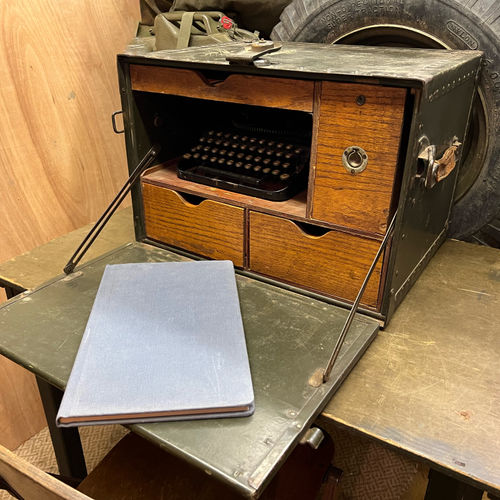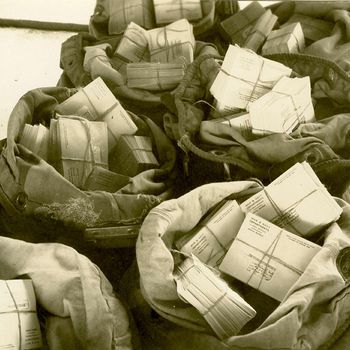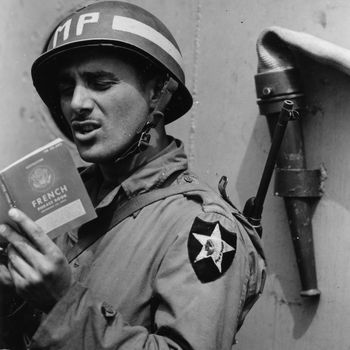This list of equipment of Assault Troops for Neptune was put together by the Office of the Quartermaster General based on lessons learned during earlier amphibious landings (such as those in the Mediterranean Theater). A particular lesson was that too much clothing and equipment had been issued. The authorized allowance filled two Barracks Bags and weighed down the disembarking troops who promptly abandoned most of it. All ETO headquarters were agreed that something should be done, but the final decision on specific items of equipment to be carried ashore by the assault troops was made by General Bradley on the advice of his Army Quartermaster Colonel McNamara.
McNamara’s concept centered on two main ideas: first, all troops should turn in their winter clothing to QM depots of SOS, which would reissue it on the Continent when needed; second, the combat troops in the assault should cut down their equipment to the absolute minimum. Troops of Divisions, Tank Destroyer, Field Artillery, Reconnaissance, and tank units fell into this category.
Although the newly-issued Duffle Bag was an improvement over the two Barracks Bags carried in North African operations, even this was judged too bulky for combat troops. Apart from items on their belts or in Haversacks, they were to carry their equipment in a blanket roll on their organizational vehicles. Some troops in the first wave wore an Assault Jacket with six pockets to carry extra articles. Personal belongings, except items that could be carried in the pockets, were to be sent home or to the QM Personal Effects Depot in Kansas City. In his account of the episode, McNamara notes that these instructions evoked considerable surprise. Some units ignored them entirely and had to be relieved of their excess equipment in the Staging Areas.
The following table has been taken from Operation Overlord, First United States Army Plan, Neptune, Annex 7, 25 February 1944. It has been reproduced here in the hope that this material will be of interest to re-enactors and collectors.
An analysis of the table reveals that this was a very frugal allowance. In addition to such parade ground items as neckties, Garrison Caps and Service Coats, each man was to turn in two blankets, one wool undershirt, one pair of wool drawers and a Barracks Bag. the men in the combat units category would also give up two cotton drawers and two cotton undershirts, one Herringbone Twill Jacket and Trousers, one Wool O.D. Shirt and Trousers, a Duffle Bag and a pair of Leggings. Certain items retained or added are also of interest. Every man would have a Raincoat (a necessity in the wet climate of northern France).
Equipment of Assault Troops for Operation “Neptune”
(D-Day to D+44)
1 Belt, Web, Waist
1 Drawers, Wool
1 Gloves, Cotton, Protective a
2 Handkerchiefs
1 Helmet, Steel, with Liner
1 Hood, Wool, Protective a
1 Jacket, Field, or Jacket, Combat, Winter (when authorized)
1 Leggings, Canvas, Protective
1 Shirt, Flannel, Protective
1 Shoes, Service, Pair
1 Socks, Wool, Protective
1 Trousers, Wool, Protective
1 Undershirt, Wool
1 Can, Meat
1 Bottle Halazone Tablets
2 Handkerchiefs
4 Heat Units – 1 ½-oz.
1 Insecticide, 2-oz. can
1 Knife
1 Raincoat
3 Socks, Wool, Light
1 Socks, Wool, Protective
1 Spoon
1 Towel, Huck
1 Bag, Canvas, Field with Strap and Suspenders (when authorized)
1 Belt, Cartridge, Pistol or BAR
1 Canteen
1 Cover, Canteen
1 Cup, Canteen
1 Haversack
1 Pack Carrier
1 Pocket, Magazine, Double Web or Pocket, Carbine (when authorized)
1 Pouch, First Aid
2 Tags, Identification, with Necklace
2 Blankets
1 Can, Meat d
1 Drawers, Cotton, Shirt
1 Fork d
2 Handkerchiefs
1 Jacket, Herringbone Twill c
1 Knife
5 Pins, Tent, Shelter Half
1 Shoes, Service
2 Socks, Wool
1 Suit, Herringbone Twill c
1 Tent, Shelter Half and Pole
1 Towel, Bath
1 Trousers, Herringbone Twill c
1 Undershirt, Cotton
a Items to be worn when and if ordered.
b Defined as Divisions and Tank Destroyer, Field Artillery, Reconnaissance, and Tank Units.
c If Herringbone Twill protective clothing was worn, it would be worn over regular OD Flannel Shirts and OD Woollen Trousers. Each unit would be initially clothed in either OD protective or Herringbone Twill protective clothing.
d Not carried by assault troops
The table does not include the following items that were issued to all assault troops:
1 x Gas Mask, Assault M5-11-7
1 x Life Preserver Belt, M1926






